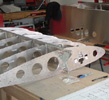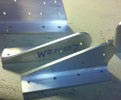


random user submitted photo
Aerovee secondary/electronic ignition current draw?
19 posts
• Page 2 of 2 • 1, 2
Re: Aerovee secondary/electronic ignition current draw?
Terry,
If there is current run through the coils continuously and interrupted to make spark, then the DC math would be true for most of the running. For the transients you are right and the inductance would have to be figured in.
If there is current run through the coils continuously and interrupted to make spark, then the DC math would be true for most of the running. For the transients you are right and the inductance would have to be figured in.
Bryan Cotton
Poplar Grove, IL C77
Waiex 191 N191YX
Taildragger, Aerovee, acro ailerons
dual sticks with sport trainer controls
Prebuilt spars and machined angle kit
Year 2 flying and approaching 200 hours December 23
Poplar Grove, IL C77
Waiex 191 N191YX
Taildragger, Aerovee, acro ailerons
dual sticks with sport trainer controls
Prebuilt spars and machined angle kit
Year 2 flying and approaching 200 hours December 23
-

Bryan Cotton - Posts: 5489
- Joined: Mon Jul 01, 2013 9:54 pm
- Location: C77
Re: Aerovee secondary/electronic ignition current draw?
marsolgp wrote:As a side note, I have gotten into the habit of switching OFF the secondary ignition once I'm airborne. It makes a huge difference (for me) with voltage I see on my meter and in keeping the battery charged up. I switch it back ON once I'm back in the pattern.
I learned to operate my Aerovee the same way. In addition to charging better, the engine also ran cooler on just the mags. I would typically see a 10 degree drop in CHTs...no change in the way the engine ran or fuel burn rate.
- radfordc
- Posts: 573
- Joined: Fri Jun 03, 2011 9:39 am
Re: Aerovee secondary/electronic ignition current draw?
Bryan Cotton wrote:Terry,
If there is current run through the coils continuously and interrupted to make spark, then the DC math would be true for most of the running. For the transients you are right and the inductance would have to be figured in.
Bryan,
The current is not constant because it is being interrupted to make spark, so therefore the inductance does in fact come into play in the calculation.
Terry
- SNX1508
- Posts: 74
- Joined: Sun Dec 11, 2011 6:53 am
Re: Aerovee secondary/electronic ignition current draw?
SNX1508 wrote:Bryan Cotton wrote:Terry,
If there is current run through the coils continuously and interrupted to make spark, then the DC math would be true for most of the running. For the transients you are right and the inductance would have to be figured in.
Bryan,
The current is not constant because it is being interrupted to make spark, so therefore the inductance does in fact come into play in the calculation.
Terry
So for the nonmathematicians does that mean when you measure that inductance is it going to mean less than 7 A or more than 7 A and by approximately how much would you expect? Personally if it's less than half an amp that's close enough for our calculations.
Jerry Hain, Tucson AZ
Waiex Electric?
CFI Glider/Airplane/Helicopter A&P
Waiex Electric?
CFI Glider/Airplane/Helicopter A&P
-

jerryhain - Posts: 81
- Joined: Thu Dec 04, 2014 1:12 pm
- Location: Sahuarita, AZ
Re: Aerovee secondary/electronic ignition current draw?
The average current will be less on a running engine than when the coils are directly measured.
I haven't directly measured our coils, but similar coils have an inductance of about 14mH and charge to 95% current in about 10 milliseconds.
At 1000 rpm, the coil fires every 30 milliseconds (one of these firings is the wasted spark). The average current through the coil will be about 88% of the steady state DC value.
At 3000 rpm, the average current will be about 67%.
It would be possible to build a system with a single coil and no wasted spark with about half the current draw, but the mechanical complexity would increase.
I haven't directly measured our coils, but similar coils have an inductance of about 14mH and charge to 95% current in about 10 milliseconds.
At 1000 rpm, the coil fires every 30 milliseconds (one of these firings is the wasted spark). The average current through the coil will be about 88% of the steady state DC value.
At 3000 rpm, the average current will be about 67%.
It would be possible to build a system with a single coil and no wasted spark with about half the current draw, but the mechanical complexity would increase.
- gammaxy
- Posts: 600
- Joined: Wed Sep 04, 2013 9:31 am
Re: Aerovee secondary/electronic ignition current draw?
jerryhain wrote:SNX1508 wrote:Bryan Cotton wrote:Terry,
If there is current run through the coils continuously and interrupted to make spark, then the DC math would be true for most of the running. For the transients you are right and the inductance would have to be figured in.
Bryan,
The current is not constant because it is being interrupted to make spark, so therefore the inductance does in fact come into play in the calculation.
Terry
So for the nonmathematicians does that mean when you measure that inductance is it going to mean less than 7 A or more than 7 A and by approximately how much would you expect? Personally if it's less than half an amp that's close enough for our calculations.
Jerry,
I am not intending to do the calculations, I was only pointing out that it was not correct to calculate the current as I=E/R (or by using inductance values from "similar coils").
Terry
- SNX1508
- Posts: 74
- Joined: Sun Dec 11, 2011 6:53 am
Re: Aerovee secondary/electronic ignition current draw?
I measured the current draw on the electronic ignition on a running Aerovee today, it drew just under 5 amps. It did not seem to vary much with RPM. It was measured using an old Simpson 260 VOM in seried with the ignition switch.
- Jerry09w
- Posts: 32
- Joined: Thu Sep 28, 2017 6:50 pm
- Location: Fruita Colorado
Re: Aerovee secondary/electronic ignition current draw?
Thanks for sharing an actual measurement while the engine is running with us :-) Out of curiosity, do you remember what the value was without the engine running? I'd expect it to be an amp or so higher.
It's interesting to me that the current didn't change much with RPM. My earlier prediction was for the current at full throttle to be about 75% that of idle. I wonder if the alternator is raising the voltage across the coils enough to approximately compensate at higher rpms.
It's interesting to me that the current didn't change much with RPM. My earlier prediction was for the current at full throttle to be about 75% that of idle. I wonder if the alternator is raising the voltage across the coils enough to approximately compensate at higher rpms.
- gammaxy
- Posts: 600
- Joined: Wed Sep 04, 2013 9:31 am
Re: Aerovee secondary/electronic ignition current draw?
Just started flying my Xenos. I see a 10 amp difference in charge rate with secondary ignition on. In other words, with primary only I see a 8 amp charge rate, with secondary on,I see -2 amps.... kind of troubling.
Bill Volcko XNS0068
Xenos A N68WV 99% flush rivets
Aerovee and Prince P-Tip
MGL Discovery Lite w/ Sandia STX 165R
V6
First hole 4/1/16
First flight 8/24/18
Phase I complete...finally!!!
Also flying a Challenger II since 1999
Xenos A N68WV 99% flush rivets
Aerovee and Prince P-Tip
MGL Discovery Lite w/ Sandia STX 165R
V6
First hole 4/1/16
First flight 8/24/18
Phase I complete...finally!!!
Also flying a Challenger II since 1999
-

bvolcko38 - Posts: 284
- Joined: Fri Feb 19, 2016 7:40 am
- Location: Finger Lakes
19 posts
• Page 2 of 2 • 1, 2
Who is online
Users browsing this forum: No registered users and 13 guests







